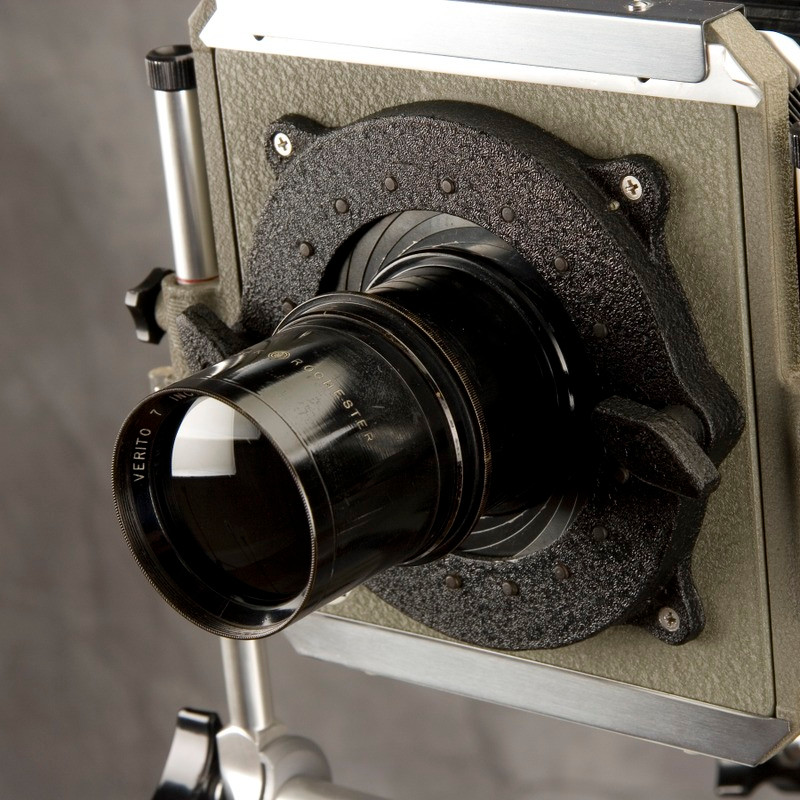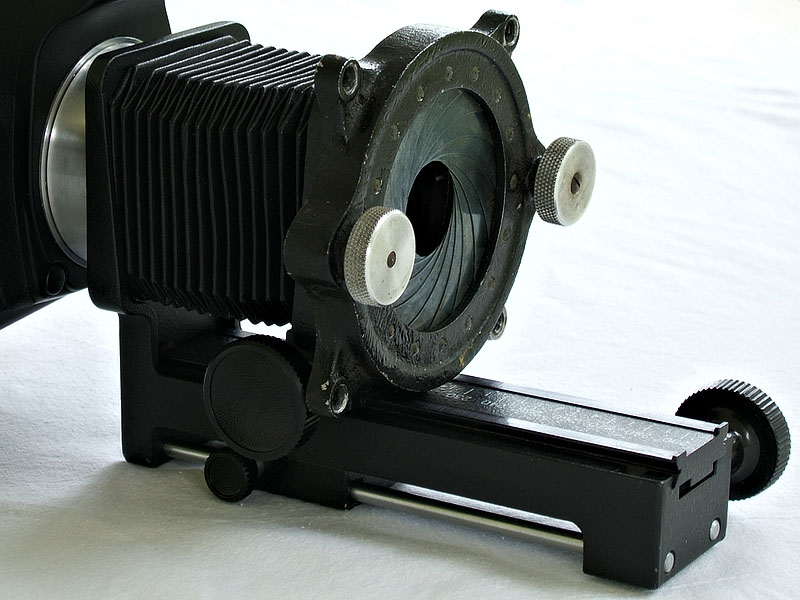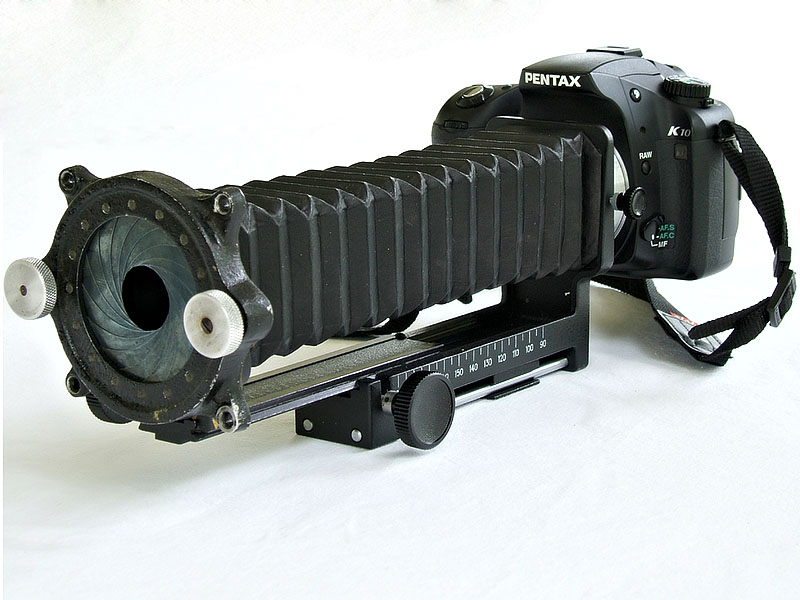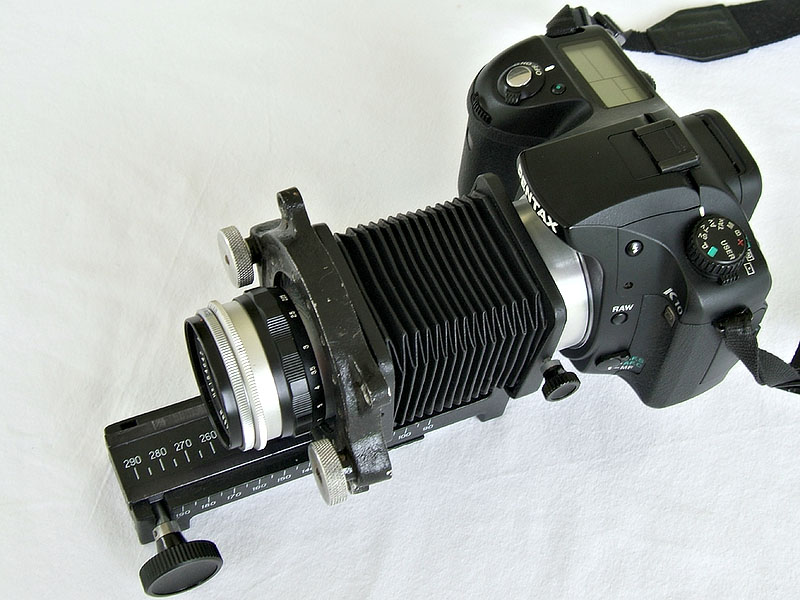| View previous topic :: View next topic |
| Author |
Message |
yoyomaoz

Joined: 31 Jul 2018
Posts: 89
Location: Adelaide
|
 Posted: Mon Jul 08, 2019 10:04 pm Post subject: Posted: Mon Jul 08, 2019 10:04 pm Post subject: |
 |
|
yoyomaoz wrote:
I have become intrigued lately with the question of how one adapts lenses such as these (and large format camera lenses etc) to a modern 35mm film camera or digital camera. I get it that its often a case of stacking multiple adapters and maybe machining or kluging up some interface adapters but can someone tell me how one might do this - using this lens as an example? Or are there already tutorials advising how to do this kind of thing published online. I am not looking for generalizations (nor at the other end of the spectrum necessarily expect specific totally complete information) but would like something with enough info to consider whether its worth me trying to adapt some old lenses designed for other purposes.
_________________
Peter M
Flickr me: https://www.flickr.com/photos/life_in_shadows/
Articles on Style and Mood in Photography
http://www.stevehuffphoto.com/2014/11/24/character-style-and-mood-in-photography-by-peter-maynard/
http://www.stevehuffphoto.com/2014/12/02/character-style-and-mood-in-photography-part-2-by-peter-maynard/
http://www.stevehuffphoto.com/2017/01/10/character-style-and-mood-in-photography-part-3-by-peter-maynard/ |
|
| Back to top |
|
 |
kds315*


Joined: 12 Mar 2008
Posts: 16664
Location: Weinheim, Germany
Expire: 2021-03-09
|
 Posted: Tue Jul 09, 2019 12:49 pm Post subject: Posted: Tue Jul 09, 2019 12:49 pm Post subject: |
 |
|
kds315* wrote:
| yoyomaoz wrote: |
| I have become intrigued lately with the question of how one adapts lenses such as these (and large format camera lenses etc) to a modern 35mm film camera or digital camera. I get it that its often a case of stacking multiple adapters and maybe machining or kluging up some interface adapters but can someone tell me how one might do this - using this lens as an example? Or are there already tutorials advising how to do this kind of thing published online. I am not looking for generalizations (nor at the other end of the spectrum necessarily expect specific totally complete information) but would like something with enough info to consider whether its worth me trying to adapt some old lenses designed for other purposes. |
I give them to my mechanic, he does that 
But I also let him have my measurements of course...
PS: I split off your topic, it "deserves" its own thread...
_________________
Klaus - Admin
"S'il vient a point, me souviendra" [Thomas Bohier (1460-1523)]
http://www.macrolenses.de for macro and special lens info
http://www.pbase.com/kds315/uv_photos for UV Images and lens/filter info
https://www.flickr.com/photos/kds315/albums my albums using various lenses
http://photographyoftheinvisibleworld.blogspot.com/ my UV BLOG
http://www.travelmeetsfood.com/blog Food + Travel BLOG
https://galeriafotografia.com Architecture + Drone photography
Currently most FAV lens(es):
X80QF f3.2/80mm
Hypergon f11/26mm
ELCAN UV f5.6/52mm
Zeiss UV-Planar f4/60mm
Zeiss UV-Planar f2/62mm
Lomo Уфар-12 f2.5/41mm
Lomo Зуфар-2 f4.0/350mm
Lomo ZIKAR-1A f1.2/100mm
Nikon UV Nikkor f4.5/105mm
Zeiss UV-Sonnar f4.3/105mm
CERCO UV-VIS-NIR f1.8/45mm
CERCO UV-VIS-NIR f4.1/94mm
CERCO UV-VIS-NIR f2.8/100mm
Steinheil Quarzobjektiv f1.8/50mm
Pentax Quartz Takumar f3.5/85mm
Carl Zeiss Jena UV-Objektiv f4/60mm
NYE OPTICAL Lyman-Alpha II f1.1/90mm
NYE OPTICAL Lyman-Alpha I f2.8/200mm
COASTAL OPTICS f4/60mm UV-VIS-IR Apo
COASTAL OPTICS f4.5/105mm UV-Micro-Apo
Pentax Ultra-Achromatic Takumar f4.5/85mm
Pentax Ultra-Achromatic Takumar f5.6/300mm
Rodenstock UV-Rodagon f5.6/60mm + 105mm + 150mm
|
|
| Back to top |
|
 |
DConvert


Joined: 12 Jun 2010
Posts: 921
Location: Essex UK
|
 Posted: Tue Jul 09, 2019 4:24 pm Post subject: Posted: Tue Jul 09, 2019 4:24 pm Post subject: |
 |
|
DConvert wrote:
| yoyomaoz wrote: |
| I have become intrigued lately with the question of how one adapts lenses such as these (and large format camera lenses etc) to a modern 35mm film camera or digital camera. I get it that its often a case of stacking multiple adapters and maybe machining or kluging up some interface adapters but can someone tell me how one might do this - using this lens as an example? Or are there already tutorials advising how to do this kind of thing published online. I am not looking for generalizations (nor at the other end of the spectrum necessarily expect specific totally complete information) but would like something with enough info to consider whether its worth me trying to adapt some old lenses designed for other purposes. |
I've mounted a few MF lenses on plastic body caps & then used them via bellows & helicoids. The same could work for LF lenses if they're small enough.
Another option is to link the digital camera to a LF body. which allows the lens movements to be used too but this is something I'm still working towards. I'm hoping to arrange it so I can stich multiple images to get the bulk of the LF image but you wouldn't have to get so complicated. |
|
| Back to top |
|
 |
visualopsins


Joined: 05 Mar 2009
Posts: 11061
Location: California
Expire: 2025-04-11
|
 Posted: Tue Jul 09, 2019 6:37 pm Post subject: Posted: Tue Jul 09, 2019 6:37 pm Post subject: |
 |
|
visualopsins wrote:
Start get a cheap LF lens. Hold it in front of your lensless camera moving back & forth until focused.
You may try adapter made from cardboard mailing tubes at first, find other options all the way to custom machining as desired.
_________________
☮☮☮☮☮☮☮☮☮☮☮☮☮☮☮☮☮☮☮☮☮☮☮☮☮☮☮☮☮☮☮☮ like attracts like! ☮☮☮☮☮☮☮☮☮☮☮☮☮☮☮☮☮☮☮☮☮☮☮☮☮☮☮☮☮☮☮☮
Cameras: Sony ILCE-7RM2, Spotmatics II, F, and ESII, Nikon P4
Lenses:
M42 Asahi Optical Co., Takumar 1:4 f=35mm, 1:2 f=58mm (Sonnar), 1:2.4 f=58mm (Heliar), 1:2.2 f=55mm (Gaussian), 1:2.8 f=105mm (Model I), 1:2.8/105 (Model II), 1:5.6/200, Tele-Takumar 1:5.6/200, 1:6.3/300, Macro-Takumar 1:4/50, Auto-Takumar 1:2.3 f=35, 1:1.8 f=55mm, 1:2.2 f=55mm, Super-TAKUMAR 1:3.5/28 (fat), 1:2/35 (Fat), 1:1.4/50 (8-element), Super-Multi-Coated Fisheye-TAKUMAR 1:4/17, Super-Multi-Coated TAKUMAR 1:4.5/20, 1:3.5/24, 1:3.5/28, 1:2/35, 1:3.5/35, 1:1.8/85, 1:1.9/85 1:2.8/105, 1:3.5/135, 1:2.5/135 (II), 1:4/150, 1:4/200, 1:4/300, 1:4.5/500, Super-Multi-Coated Macro-TAKUMAR 1:4/50, 1:4/100, Super-Multi-Coated Bellows-TAKUMAR 1:4/100, SMC TAKUMAR 1:1.4/50, 1:1.8/55
M42 Carl Zeiss Jena Flektogon 2.4/35
Contax Carl Zeiss Vario-Sonnar T* 28-70mm F3.5-4.5
Pentax K-mount SMC PENTAX-A ZOOM 1:3.5 35~105mm, SMC PENTAX ZOOM 1:4 45~125mm
Nikon Micro-NIKKOR-P-C Auto 1:3.5 f=55mm, NIKKOR-P Auto 105mm f/2.5 Pre-AI (Sonnar), Micro-NIKKOR 105mm 1:4 AI, NIKKOR AI-S 35-135mm f/3,5-4,5
Tamron SP 17mm f/3.5 (51B), Tamron SP 17mm f/3.5 (151B), SP 500mm f/8 (55BB), SP 70-210mm f/3.5 (19AH)
Vivitar 100mm 1:2.8 MC 1:1 Macro Telephoto (Kiron)
|
|
| Back to top |
|
 |
kypfer

Joined: 27 Sep 2017
Posts: 523
Location: Jersey C.I.
|
 Posted: Tue Jul 09, 2019 9:27 pm Post subject: Posted: Tue Jul 09, 2019 9:27 pm Post subject: |
 |
|
kypfer wrote:
| DConvert wrote: |
| I've mounted a few MF lenses on plastic body caps & then used them via bellows & helicoids. The same could work for LF lenses if they're small enough. |
I use this approach as well. A bit of careful searching can find some fashionably desirable lenses (eg. Trioplan) fitted to old folding cameras which can be bought for very little if the seller doesn't realise what they've got 
Anything from a cardboard tube and/or extension tube can be used as a temporary mount for assessment purposes. Make sure the internal surfaces are nice and matt black to eliminate reflections! |
|
| Back to top |
|
 |
jamaeolus


Joined: 19 Mar 2014
Posts: 2971
Location: Eugene
Expire: 2015-08-20
|
 Posted: Tue Jul 09, 2019 10:17 pm Post subject: Posted: Tue Jul 09, 2019 10:17 pm Post subject: |
 |
|
jamaeolus wrote:
I have a good bit of fun with the old folder lenses. Quality varies considerably from manufacturer to manufacturer and within a companies products from lens type to lens type and yet again from example to example. I look for older folders from Balda, Franka, Welta, Zeiss Ikon, Nagel, Certo and especially ones sold "as is" but the glass can be seen. I generally use the "hold it up in front of sensor" technique for a rough estimate then use a nex m42 close ring (I bought 10 of them when I spotted them on e-bay!) then m42 helicals and extension tubes to the length needed. Depending on the base of the lens I will mount to a lens cap or use "Blue-Tak" (TM) to temporarily fix the lens to the adapters. I like to look at photos of the cameras front as, often the seller will not name the lens, but it is nearly always on the bezel of the lens. Enjoy.
Blue Tak is a trade name of one kind of poster board mounting "clay". Its very much like silly putty and can be formed to different shapes. It holds reasonably well for most of these kinds of things allowing a solid mount (as opposed to free lensing) for a decent test of the lens capabilities. It comes off cleanly leaving little or no residue and if there is residue it is easily removed with a soft rag and alcohol.
_________________
photos are moments frozen in time |
|
| Back to top |
|
 |
e6filmuser

Joined: 12 Nov 2010
Posts: 860
Location: Reading UK
|
 Posted: Fri Jul 12, 2019 8:04 pm Post subject: Posted: Fri Jul 12, 2019 8:04 pm Post subject: |
 |
|
e6filmuser wrote:
On m4/3 I find I need about 220 or 230mm of total extension. That's for macro.
_________________
Dedicated to using manual focus lenses with digital. Equiped for photography from macro to panoramic & from ultra-wide to extreme telephoto. Mostly shooting outdoor macro. Experienced entomological taxonomist. Some knowledge of mushrooms. |
|
| Back to top |
|
 |
Paulius


Joined: 25 Nov 2014
Posts: 327
Location: Connecticut
|
 Posted: Sun Jul 14, 2019 3:17 am Post subject: Posted: Sun Jul 14, 2019 3:17 am Post subject: |
 |
|
Paulius wrote:
Another option is to link the digital camera to a LF body. which allows the lens movements to be used too but this is something I'm still working towards. I'm hoping to arrange it so I can stich multiple images to get the bulk of the LF image but you wouldn't have to get so complicated.[/quote]
-----------------------------------------------
I'm using a Baby Graphic body, it is not so bulky, but the size of lenses is limited, the lens boards on this camera are small. The Sony camera goes on the former film holder with the Sony camera's cut through cower with NEX bayonet in the center of it. |
|
| Back to top |
|
 |
philslizzy


Joined: 07 Aug 2012
Posts: 4745
Location: Cheshire, England
|
 Posted: Mon Jul 15, 2019 9:55 pm Post subject: Posted: Mon Jul 15, 2019 9:55 pm Post subject: |
 |
|
philslizzy wrote:
You can get focusing helicals on ebay. I have a small selection exactly for this purpose. Most helicals are M42-M42 or Camera fitting e.g NEX to M42. My way round it is this.
Needed:
Plastic card
Epoxy resin
M39-M42 adapter (I keep several exactly for this purpose)
Focusing helical (your camera at one end and M42 at the lens end.)25-55mm or an M42-M42 and a regular M42 adapter
Remove the lens from the camera (if it's a folder) by turning the retaining ring behind the lens. Most do this. Many large format lenses have retaining rings too.
Get the piece of stiff plastic card - I use blank, creditcard sized cards, but anything will do as long as you can glue it so avoid LDPE or HDPE or nylon.
Cut a hole in it wide enough for the screw thread at the rear of the lens and attach the lens with the retaining ring.
Trim the plastic so it looks neat.
Screw the adapter into the helical until it's flush and mark the top (scratch it with a pin or something) then remove it.
Glue the adapter ring to the card around the back of the lens making sure the mark on the adapter ring is aligned to the top of the lens.
Fit the lens then...
Attach it to your helical. You can use extension tubes if necessary to get the focus. The 25-55 has enough 'throw' to work with long focus lenses.

_________________
Hero in the 'messin-with-cameras-for-the-hell-of-it department'. Official. |
|
| Back to top |
|
 |
Abbazz


Joined: 23 Jun 2007
Posts: 1098
Location: Jakarta
|
 Posted: Mon Jul 15, 2019 11:15 pm Post subject: Universal iris lens mount Posted: Mon Jul 15, 2019 11:15 pm Post subject: Universal iris lens mount |
 |
|
Abbazz wrote:
In my opinion, the most flexible solution is the universal iris lens mount. This is a lens mounting flange made of a study iris diaphragm designed to hold any kind of lens in front of a large format camera:

Credit: https://www.surpluscameragear.com/universal-iris-lens-mount/
It's easy to adapt one of those on a bellows designed for small format cameras in order to allow mounting old lenses, including large format barrel lenses and projector lenses:



The only problem is finding one of these devices, which mowadays have become as rare as hen's teeth.
Cheers!
Abbazz
_________________
Il n'y a rien dans le monde qui n'ait son moment decisif, et le chef-d'oeuvre de la bonne conduite est de connaitre et de prendre ce moment. - Cardinal de Retz
The 6x9 Photography Online Resource:
http://artbig.com/ |
|
| Back to top |
|
 |
jamaeolus


Joined: 19 Mar 2014
Posts: 2971
Location: Eugene
Expire: 2015-08-20
|
 Posted: Tue Jul 16, 2019 4:23 pm Post subject: Posted: Tue Jul 16, 2019 4:23 pm Post subject: |
 |
|
jamaeolus wrote:
Thanks for that reference, Abbazz. Looks to be a very suitable way to adapt oddball lenses.
_________________
photos are moments frozen in time |
|
| Back to top |
|
 |
|
|
|
You cannot post new topics in this forum
You cannot reply to topics in this forum
You cannot edit your posts in this forum
You cannot delete your posts in this forum
You cannot vote in polls in this forum
|
